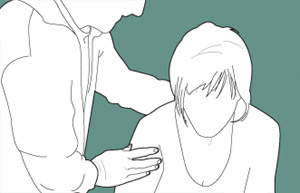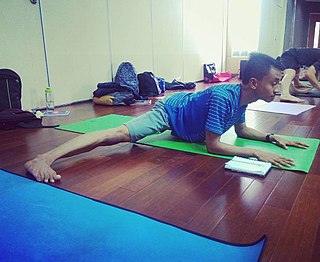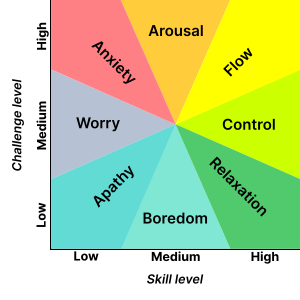
Meditation is a practice in which an individual uses a technique – such as mindfulness, or focusing the mind on a particular object, thought, or activity – to train attention and awareness, and achieve a mentally clear and emotionally calm and stable state.

Panic attacks are sudden periods of intense fear and discomfort that may include palpitations, sweating, chest pain or chest discomfort, shortness of breath, trembling, dizziness, numbness, confusion, or a feeling of impending doom or of losing control. Typically, symptoms reach a peak within ten minutes of onset, and last for roughly 30 minutes, but the duration can vary from seconds to hours. Although they can be extremely frightening and distressing, panic attacks themselves are not physically dangerous.
Stress management consists of a wide spectrum of techniques and psychotherapies aimed at controlling a person's level of stress, especially chronic stress, usually for the purpose of improving everyday functioning. Stress produces numerous physical and mental symptoms which vary according to each individual's situational factors. These can include a decline in physical health, such as headaches, chest pain, fatigue, and sleep problems, as well as depression. The process of stress management is named as one of the keys to a happy and successful life in modern society. Life often delivers numerous demands that can be difficult to handle, but stress management provides a number of ways to manage anxiety and maintain overall well-being.

Biofeedback is the technique of gaining greater awareness of many physiological functions of one's own body by using electronic or other instruments, and with a goal of being able to manipulate the body's systems at will. Humans conduct biofeedback naturally all the time, at varied levels of consciousness and intentionality. Biofeedback and the biofeedback loop can also be thought of as self-regulation. Some of the processes that can be controlled include brainwaves, muscle tone, skin conductance, heart rate and pain perception.
Autogenic training is a relaxation technique first published by the German psychiatrist Johannes Heinrich Schultz in 1932. The technique involves repetitions of a set of visualisations accompanied by vocal suggestions that induce a state of relaxation and is based on passive concentration of bodily perceptions like heaviness and warmth of limbs, which are facilitated by self-suggestions. Autogenic training is used to alleviate many stress-induced psychosomatic disorders.
Mind–body interventions (MBI) or mind-body training (MBT) are health and fitness interventions that are intended to work on a physical and mental level such as yoga, tai chi, and Pilates.

Yoga nidra or yogic sleep in modern usage is a state of consciousness between waking and sleeping, typically induced by a guided meditation.
Mindfulness is the cognitive skill, usually developed through meditation, of sustaining meta-attention of the contents of one's own mind in the present moment. Mindfulness derives from sati, a significant element of Hindu and Buddhist traditions, and is based on Zen, Vipassanā, and Tibetan meditation techniques. Though definitions and techniques of mindfulness are wide-ranging, Buddhist traditions describe what constitutes mindfulness, such as how perceptions of the past, present and future arise and cease as momentary sense-impressions and mental phenomena. Individuals who have contributed to the popularity of mindfulness in the modern Western context include Thích Nhất Hạnh, Joseph Goldstein, Herbert Benson, Jon Kabat-Zinn, and Richard J. Davidson.
A relaxation technique is any method, process, procedure, or activity that helps a person to relax; attain a state of increased calmness; or otherwise reduce levels of pain, anxiety, stress or anger. Relaxation techniques are often employed as one element of a wider stress management program and can decrease muscle tension, lower blood pressure, and slow heart and breath rates, among other health benefits.

Breathwork is a term for various breathing practices in which the conscious control of breathing is said to influence a person's mental, emotional, or physical state, with a therapeutic effect.

Yoga as therapy is the use of yoga as exercise, consisting mainly of postures called asanas, as a gentle form of exercise and relaxation applied specifically with the intention of improving health. This form of yoga is widely practised in classes, and may involve meditation, imagery, breath work (pranayama) and calming music as well as postural yoga.
Progressive muscle relaxation (PMR) is a method of deep muscle relaxation that does not involve any medications, meaning it is a non-pharmacological intervention. The idea behind progressive muscle relaxation is that there is a relationship between a person's mind and body. The body responds to its environment by creating certain mind or body states such as anxiety, stress, and fear. When the body is in these states, the muscles tense up. Progressive muscle relaxation aims to reverse these body states back to more neutral, relaxed states.
Conscious breathing encompasses techniques directing awareness toward the breathing process, serving purposes from improving respiration to building mindfulness. In martial arts like tai chi and qigong, breathing exercises are said to strengthen diaphragm muscles and protect organs, with reverse breathing being a common method. Meditation traditions, including yoga and Buddhist meditation, emphasize breath control. Yoga's pranayama is believed by practitioners to elevate life energies, while Buddhist vipassanā uses anapanasati for mindfulness of breathing.

The psychological and physiological effects of meditation have been studied. In recent years, studies of meditation have increasingly involved the use of modern instruments, such as fMRI and EEG, which are able to observe brain physiology and neural activity in living subjects, either during the act of meditation itself or before and after meditation. Correlations can thus be established between meditative practices and brain structure or function.
Sport psychology was defined by the European Federation of Sport Psychology (FEPSAC) in 1996, as the study of the psychological basis, processes, and effects of sport. Otherwise, sport is considered as any physical activity where the individuals engage for competition and health. Sport psychology is recognized as an interdisciplinary science that draws on knowledge from many related fields including biomechanics, physiology, kinesiology and psychology. It involves the study of how psychological factors affect performance and how participation in sport and exercise affect psychological and physical factors. Sport psychologists teach cognitive and behavioral strategies to athletes in order to improve their experience and performance in sports.
Sophrology is a dynamic relaxation method developed by neuropsychiatrist Alfonso Caycedo from 1960 to 2001 and includes physical and mental exercises to promote health and well-being. Sophrology has been called “a method, a practice and a philosophy” that uses the mind-body connection to increase awareness and conscious living, with the aim of enabling individuals to create more balance and harmony in themselves and in the world around them.
Pain psychology is the study of psychological and behavioral processes in chronic pain. Pain psychology involves the implementation of treatments for chronic pain. Pain psychology can also be regarded as a branch of medical psychology, as many conditions associated with chronic pain have significant medical outcomes. Untreated pain or ineffective treatment of pain can result in symptoms of anxiety, depression, and suicidal thoughts, thus it is vital that appropriate pain management occur in a timely fashion following symptom onset.
Cancer phobia, also known as carcinophobia, is a common phobia and an anxiety disorder characterized by the chronic fear of developing cancer. It can manifest in tremendous feelings of sadness, fear, panic, and distress. In some cases, the phobia can be so extreme that it prevents the individual from living a normal life.
Trauma-sensitive yoga is yoga as exercise, adapted from 2002 onwards for work with individuals affected by psychological trauma. Its goal is to help trauma survivors to develop a greater sense of mind-body connection, to ease their physiological experiences of trauma, to gain a greater sense of ownership over their bodies, and to augment their overall well-being. However, a 2019 systematic review found that the studies to date were not sufficiently robustly designed to provide strong evidence of yoga's effectiveness as a therapy; it called for further research.

The science of yoga is the scientific basis of modern yoga as physical exercise in human sciences such as anatomy, physiology, and psychology. Yoga's effects are to some extent shared with other forms of exercise, though it differs in the amount of stretching involved, and because of its frequent use of long holds and relaxation, in its ability to reduce stress. Yoga is here treated separately from meditation, which has effects of its own, though yoga and meditation are combined in some schools of yoga.













